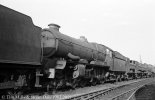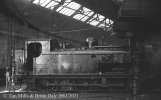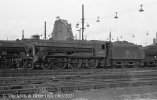Following up the comments above I'll certainly have to wear a hair shirt at some time!
Jordan - Private scrapyards all tended to scrap the locos they were sent in quick order. This was, after all, a source of cash flow for them. In fact we were lucky to have Woodham's on so may levels and I don't know the economies of Dai's business but it seems possible that he had a good contract with BR to scrap wagons and invested in the steam locos because he had some spare cash, the rental of the land at Barry was cheap and he gambled on the value of scrap metal increasing. As it happened he probably did well out of us preservationists! (And all power to his elbow for that). You'll doubtless be aware that occasional locos were scrapped at Barry when the supply of wagons dried up.
As for litter it seems to be a cultural thing apart from anything else. I've noted that most European countries have a similar littering problem to us - perhaps Germany and Belgium are a bit better. Africa (well Kenya) and India have a huge issue, and when I was in Kenya there were polythene bags all over the trees as one came near to a township. China suffers pollution but of a different sort. Most of Singapore is so clean you could eat a meal off the pavement. We come somewhere in the middle, I guess.
And before anyone accuses me of typecasting I'll admit that the above observations are personal and sweeping generalisations.
Graham - Clutter around the sheds seemed to increase as steam edged towards extinction. At the time I fear there was little pride in the job, not helped by the management or governmental interference at the time. I have some negs in my possession of Old Oak just pre second world war and the absence of clutter and trip hazards is very notable.
Simon and Dave - I too remember Corona bottles (well, my dad told me about them.....

) It was part of the visit to Southall footbridge to collect a Corona on the way and return it to the shop on the way home so you had the money for the bus fare (well, I'm exaggerating with that last bit but you get the idea).
Dave. That location is perfect, and thanks again.
Mick and Martin - Hair shirt time.


I should have referred that image to you before publishing it. In fact I'm sure you are right - the two negs in question are next to one another so it's almost certain that Tim turned and took the photo of the train travelling away from him. To my ignorant eye it looked like an A3 and could, of course, have been a following train, but I'm utterly convinced by your proposal and I'll change the description accordingly.
In truth, as far as these images are concerned when we have so little original detail WT is a tremendous source of knowledge and I'm pretty sure that I'll make some similar mistakes in the future. I'm really grateful to those who take the time to correct my errors.
Back to the GWR but only briefly before we start on a few from the LMR.
Old Oak Yard in May 1963 and a King languishes after withdrawal. I'm strongly of the opinion that it's 6023 King Edward II which I photographed in he same position and with pannier tanks in the same orientation behind in September 1963. It had been resident at Old Oak from June 1956 and was withdrawn in June 1962. As a result of a happy accident involving bridge weight testing it ended up at Woodham's. Brief details of 6023's career post withdrawal and leading up to preservation appear in my Barry 1967 and 1968 thread so I'll not repeat here.

So here's condensing pannier tank 9706 in Old Oak in May 1963. I'm uncertain whether I've written this one up previously so here's a brief synopsis. As far as I can tell it had been an Old Oak engine for ever and was withdrawn from there in November 1964. It went to RS Hayes/Birds, Tremains Yard, Bridgend where it was scrapped by the end of February 1965.

Across the road - well, along the canal a bit - to Willesden Shed in May 1963. This is a really good record shot of Caprotti Black 5 44752. The Caprotti 5s were not often seen at Willesden. At the time it was a Stockport Edgeley loco being withdrawn from there in the middle of April 1964. It was scrapped at Crewe Works in June.

Brian














 It's an A1, if you look closely there's a straight bit of deflector before the lower half is obscured by steam, plus the handrail is too large and has a faint riser section, the A3 Witte deflectors have two much thinner horizontal hand rails.
It's an A1, if you look closely there's a straight bit of deflector before the lower half is obscured by steam, plus the handrail is too large and has a faint riser section, the A3 Witte deflectors have two much thinner horizontal hand rails.
 ) It was part of the visit to Southall footbridge to collect a Corona on the way and return it to the shop on the way home so you had the money for the bus fare (well, I'm exaggerating with that last bit but you get the idea).
) It was part of the visit to Southall footbridge to collect a Corona on the way and return it to the shop on the way home so you had the money for the bus fare (well, I'm exaggerating with that last bit but you get the idea).
 I should have referred that image to you before publishing it. In fact I'm sure you are right - the two negs in question are next to one another so it's almost certain that Tim turned and took the photo of the train travelling away from him. To my ignorant eye it looked like an A3 and could, of course, have been a following train, but I'm utterly convinced by your proposal and I'll change the description accordingly.
I should have referred that image to you before publishing it. In fact I'm sure you are right - the two negs in question are next to one another so it's almost certain that Tim turned and took the photo of the train travelling away from him. To my ignorant eye it looked like an A3 and could, of course, have been a following train, but I'm utterly convinced by your proposal and I'll change the description accordingly.




